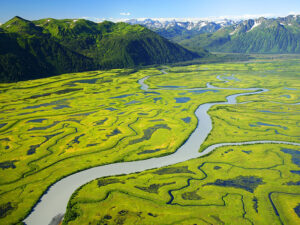Kindergarten - Discovering Our Blue Planet
SUMMARY
A 3-4 Week Unit for Primary Level
This unit is designed for kindergarten, but could be adapted to other primary grades. Students discover aquatic environments and the living and nonliving things that are found in them, through active observation outdoors and in the classroom. They practice skills of recording, comparing, questioning, and communicating. Science notebooks are used throughout the unit to help students understand and organize information.
Essential Question
- What are the characteristics of the living and nonliving things you discover in the water?
Enduring Understandings
- Living and nonliving things in Alaska waters come in a great assortment of colors, shapes, and sizes.
- Living things move, grow, and change.
Ocean Literacy Principle Addressed
- The ocean supports a great diversity of life and ecosystems.
LESSON PLANS

Aquatic Puzzles
Children will assemble simple puzzles to learn more about aquatic animals and their life cycles. How do we know living and nonliving things are in the water around us? What do they look like when they are growing?
View Lesson Plan
Location: Large Space, Outside
Activity Type: Hands-On

Drawing from Description
Changing Landscape asks students to analyze “repeat photographs” (taken from the same vantage point at different times) of Alaska glaciers to observe the effects of retreating glaciers on the landscape.
View Lesson Plan
Location: Classroom, Large Space, Outside
Activity Type: Hands-On

Field Trip to a Local Habitat
Children go outdoors to explore a local habitat. They see, feel, and think about the living and nonliving things in the water. Science notebooks are used to gather information about what they find. Students use their background knowledge from prior classroom experiences, the initial field trip, classroom investigations, and other observations to notice and observe the living and nonliving things in their environment. Students have plenty of time to explore and discover before being asked to write and draw in their science notebooks.
View Lesson Plan
Location: Classroom, Large Space, Outside
Activity Type: Game, Hands-On

Globe Toss
In this activity, students begin their discovery of aquatic environments, and start to notice that water is all around them, in their neighborhoods, backyards, oceans, rivers, ponds, and creeks. They take a first look at “Our Big Blue Planet” with a globe game.
View Lesson Plan
Location: Classroom, Large Space
Activity Type: Game, Hands-On

Water Detectives
In this activity, students begin their discovery of aquatic environments, and start to notice that water is all around them, in their neighborhoods, backyards, oceans, rivers, ponds, and creeks. They act as outdoor “Water Detectives” to explore and map water on a walk near their school.
View Lesson PlanAUTHORS
Jennifer Thompson, Kindergarten Teacher, Juneau
Chris Thomas, Retired K-1 Teacher, Juneau
Stephanie Hoag, Curriculum Consultant, Juneau
Marla Brownlee, Alaska Sea Grant
With special thanks to Dayna Focht of Juneau for ideas and activities.
